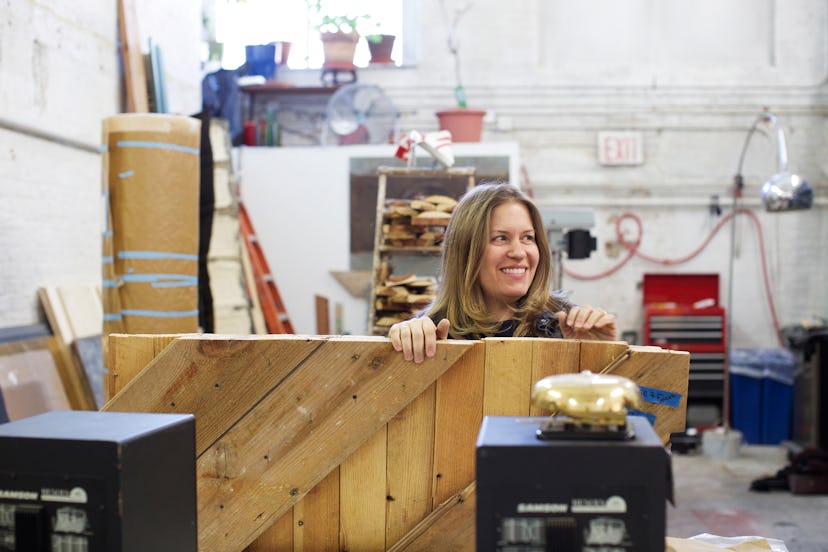Natural Selection

Raised on a farm just outside of Nashville, Tennessee, artist Virginia Overton brings a bucolic resourcefulness to her work. Drawn to natural elements such as cedar and bronze as well as found objects like abandoned tires and Styrofoam coolers, Overton is best known for the responsive site-specific installations she erects using her unlikely combination of ingredients. A hoarder of sorts, the artist stores her materials at her Williamsburg studio, which acts as both a lab and a library for her visual research. Here, she discusses her collection of junk, the importance of site visits, and her upcoming exhibition at White Cube Mason’s Yard gallery in London.
Virginia Overton’s exhibition will be on view from January 16th to March 14th at White Cube Mason’s Yard, 25 – 26 Mason’s Yard, London, + 44.207.930.5373.
Virginia Overton in her Brooklyn studio.
“I moved in just last February. I know it’s amazing how much junk I have in here already. It goes through phases, but it’s usually pretty chaotic. I move things out of the way just enough to work.”
“The place where I grew up is called Lebanon, because of the amount of cedar trees. They were a big part of my vision. When I did my first show in New York, I worked with my parents and my sister to chose trees from around the farm. I didn’t want to fill the space with objects—I wanted to fill it with the smell of cedar.”
“My work is driven by the material itself. I’ll see some material somewhere and pick it up and bring it in here. It’s a constant process.”
“I like to imagine this pinecone being really gigantic. These weird little combinations of materials allow me to work on a different scale and test out ideas.”
“I’ve gone to Mason’s Yard with this show in mind three times. Site visits are important for me. When I’m there, I take notes mentally. Then I put everything in the hopper and see what comes out. I take a lot of pictures on my phone, too. I have about twenty thousand photos.”
“I grew up on a farm in Tennessee, and so the use and reuse of materials was always really important. You have to make things go as far as they can. Realizing the usefulness of a material as far as you can is important to me.”
“These were my grandmother’s. I remember as a kid looking at these postcards of New York. Now they are inspiration.”
“I’ve been teaching this fall, so I’ve been gone a lot. I usually come to the studio first thing. I like to turn on some music and the lights to get the space warmed up. ”
“I played a clawhammer in college—that’s a kind of banjo. Now I play the ukulele. It’s much easier to travel with.”
“During a site visit, I like to look at what’s natural to an area and try to use those components. At the gallery [White Cube Mason’s Yard], if you are up on the terrace, you can see all the weathervanes, so I wanted to make one. It’s going to be forged from steel by a maker from Sussex. I actually made this copper one last year for the Kunsthalle in Bern. The idea was to give it to my sister to put on top of her barn. Eventually it’ll make it there. ”
“It’s physically difficult to deal with some of these materials. I do a lot of stuff in here by myself that I shouldn’t. Things fall on me. I have bruises and cut myself. I go home with dirt all down the front of my jeans. I like pushing my limits.”
“When it comes to bigger installations, I need to work with a group of people. I might have this idea about the way I want to install something, but maybe someone else has a more ingenious way to go about it. Respect for your community and knowing what it provides you in life is lost a lot of times—especially as an artist.”